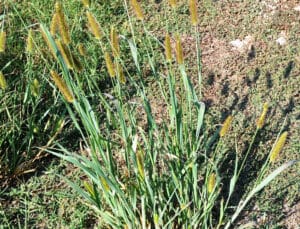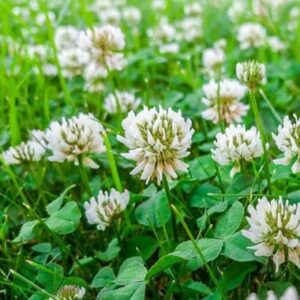Scientific Name: Cyperus esculentus
Description:
This species thrives in moist, poorly drained soils and can persist in full sun and moderate shade. Yellow nutsedge (Cyperus esculentus) is an aggressive weed that spreads via underground stems and tubers. Many turf managers and homeowners find its yellow color, coarse texture, and fast growth rate objectionable in stands of cool-season turf. Fortunately, yellow nutsedge is relatively easy to identify and can be controlled using good cultural practices and proper herbicides applied at the correct stage of growth.
Life Cycle:
Yellow nutsedge is a member of the sedge family (Cyperaceae) and has a perennial life cycle. This species can occasionally reproduce by seed, but new plants are primarily produced from nodes on rhizomes and from tubers (often referred to as nutlets). Rhizomes and tubers can also serve as overwintering structures. In most of Pennsylvania, tubers begin to form at the tips of rhizomes in late June or early July. A single plant can produce multiple tubers which can remain dormant in soil from one to several years before germinating. Leaves and stems of yellow nutsedge emerge from growing points on rhizomes and from tubers in spring, and new plants continue to develop throughout the growing season. Leaves and stems grow rapidly during warm weather in summer when leaf growth of cool-season turfgrasses slows. The foliage of yellow nutsedge dies back in the fall following the first hard frost.
Identification:
Yellow nutsedge is easily distinguished from turfgrasses by its yellow-green color and coarse, shiny foliage. Stem bases typically show a reddish hue when outer leaf sheaths are stripped away. As with most members of the sedge family, yellow nutsedge has angular, three-sided stems, which can be detected by holding and turning the stem base between your thumb and index finger. Making a cross-section cut of the stem with a sharp knife will reveal the triangular shape of the stem. Although the brown seedheads of yellow nutsedge rarely appear in turf, they are frequently visible in non-mowed areas such as flower beds and naturalized grass stands on golf courses, and can be used as an identifying feature of this weed.
Cultural Control:
Yellow nutsedge is typically introduced into turf stands through the transfer of soil contaminated with tubers and rhizomes. Although there are no practical means of detecting reproductive structures in soil, using soils from sites with no previous history of yellow nutsedge infestation can lessen the chances of contamination. If only a few yellow nutsedge plants are infesting a lawn, they can be removed by hand pulling soon after leaf emergence in spring and before tubers form later in the growing season. Be sure to remove as much of the below-ground portion of the plants as possible, as broken bits of rhizomes can give rise to new plants. Improving turf density through fertilization, regular mowing, and use of turfgrasses well-adapted to site conditions will help to slow the spread of yellow nutsedge, but may not provide effective suppression once it becomes established.
Chemical Control:
The most effective control of yellow nutsedge with herbicides is obtained when foliage is visible in the turf canopy (3 to 8 leaf stage), and before tubers begin to mature in mid to late summer. It’s important to treat nutsedge before tubers mature because these underground structures can give rise to many new plants in subsequent years. Herbicides are typically most effective in controlling nutsedge when mowing is curtailed at least 2 to 3 days before and after application.
Herbicides labeled for control or suppression of yellow nutsedge in cool-season turf include bentazon (Basagran T&O); sulfentrazone and sulfentrazone-containing products (Dismiss, Surepyc, Dismiss NXT, Solitare, Solitare WSL, Echelon 4SC, Q4 Plus, Foundation, Momentum 4-Score, SureZone, Surge, and TZone SE); halosulfuron-methyl (Sedgehammer, Prosedge, and Sedgemaster); imazosulfuron (Celero); mesotrione (Tenacity); and dimethenamid-P (Tower). A new nutsedge herbicide, pyrimisulfan (Vexis), is expected to be available for use on turfgrass in 2019.
Bentazon
Basagran T&O is a selective contact herbicide that contains bentazon, a photosynthesis inhibitor in susceptible weeds, as the active ingredient. This herbicide is relatively fast-acting, with injury symptoms appearing on nutsedge within 5 to 7 days of treatment. Basagran T&O can be used on established Kentucky bluegrass, fescues, ryegrass, and bentgrass for control of yellow nutsedge and some broadleaf weeds. The label rate for nutsedge control is 24 to 32 fl oz per acre (0.55 to 0.75 fl oz per 1000 sq ft). Control can be improved with the addition of a methylated seed oil or crop oil concentrate. A second application can be made 7 to 10 days after the first application if needed, but no less than 21 days after the first application on perennial ryegrass. Trials at Penn State indicate that Basagran T&O is effective for yellow nutsedge control using a single application of 0.75 fl oz product per 1000 sq ft. Foliar injury has been observed with this product on perennial ryegrass in heat and drought stress situations.
Sulfentrazone and sulfentrazone-containing products
Dismiss and Surepyc are contact herbicides labeled for control of yellow nutsedge and contain 39.6% sulfentrazone as the active ingredient. Sulfentrazone is classified as a protox inhibitor, a group of herbicides characterized by their disruptive effects on membrane function. In contrast to most systemic herbicides, Dismiss and Surepyc are very fast-acting. A recent trial at Penn State demonstrated pronounced injury symptoms on yellow nutsedge 2 days following an early July application, and treated plants were no longer visible in the stand 10 days after application. Both products are labeled for use on most turfgrasses grown in Pennsylvania but can cause foliar injury to some cultivars of fine fescues. Neither product is labeled for use on putting greens. Rates of Dismiss and Surepyc for yellow nutsedge control in cool-season turfgrasses range from 4 to 8 fl oz product per acre, and no surfactant is required.
Dismiss NXT contains sulfentrazone and a small amount of carfentrazone-ethyl (3.53%) and is labeled for control or suppression of yellow nutsedge and some broadleaf weeds. Solitare and Solitare WSL (sulfentrazone and quinclorac) are also labeled for control or suppression of yellow nutsedge and broadleaf weeds in most cool-season turfgrasses. Echelon 4SC (sulfentrazone and prodiamine) is labeled for postemergence control or suppression of yellow nutsedge in turf, as well as preemergence control in non-cropland, bare ground areas. Users should be aware of extended seeding restriction intervals after using Echelon 4SC due to the preemergence herbicide activity of prodiamine. Some other sulfentrazone-containing products, such as Foundation, Momentum 4-Score, SureZone, Surge, and TZone SE, have small concentrations of sulfentrazone and are only labeled for suppression of yellow nutsedge.
Halosulfuron-methyl
Sedgehammer, Prosedge, and Sedgemaster are herbicide products that contain the active ingredient halosulfuron-methyl, a sulfonylurea herbicide with systemic activity. These products are labeled for use on most cool-season turfgrasses. Rates of the water-dispersible granule (WDG) formulation of Sedgehammer, Prosedge, and Sedgemaster are very low (2/3 to 1 1/3 oz of product per acre), and labels suggest adding a non-ionic surfactant at 0.25% v/v to the spray solution for optimum control of yellow nutsedge. If needed, another application can be made 6 to 8 weeks after the initial application. Sedgehammer+ is a special formulation that is premixed with a surfactant, so you don’t have to add surfactant to the spray solution.
If you only need to make spot treatments to individual yellow nutsedge plants (or small groups of plants), the WDG formulation of Sedgehammer, Prosedge, and Sedgemaster is available in small (1.3 oz) bottles, which is enough to treat 1 acre. Mix 0.9 gram of the WDG formulation using the measuring scoop provided with the product in 1 or 2 gallons of water to treat 1000 sq ft. Directions call for the addition of 2 teaspoons (1/3 fl oz) of a nonionic surfactant per gallon of water.
Sedgehammer, Prosedge, and Sedgemaster are most effective when applied to nutsedge at the 3 to 8 leaf stage. Although very effective, halosulfuron-methyl-containing products act slowly. In a trial conducted at Penn State, injury symptoms following a Sedgehammer treatment did not become visible until about a week after application, with complete desiccation occurring three weeks later. Although slow-acting, the active ingredient will eventually translocate to the rhizomes and tubers and kill the entire plant. For best results, do not mow 2 to 3 days before or after application.
Imazosulfuron
Celero herbicide contains the active ingredient imazosulfuron, which is a member of the sulfonylurea herbicide class and has systemic activity in susceptible plants. This product is labeled for use on most cool-season turfgrasses and controls several different sedge species and some broadleaf weeds. Rates of Celero for yellow nutsedge control range from 8 to 14 oz per acre, and a non-ionic surfactant at 0.25% v/v must be added to the spray solution for optimum control. Applications should commence after nutsedge plants have reached the 3-leaf stage of growth. For heavy yellow nutsedge infestations, a second application can be made 21 days after the first treatment.
Mesotrione
Tenacity is a popular herbicide that controls stubborn grassy weeds such as bentgrass, nimblewill, crabgrass, and yellow nutsedge. The active ingredient is mesotrione, a carotenoid inhibiting compound that causes susceptible plants to turn white. Tenacity has systemic activity but is somewhat slow-acting. White plants create highly visible treatment effects, which may be objectionable in some cases. However, Tenacity has the advantage of being safe on newly seeded turf (except fine fescues) and can provide some preemergence and postemergence control of crabgrass. Hence, this herbicide may be a good choice if young crabgrass plants are present with nutsedge in the same stand.
Tenacity is labeled for use on most cool-season grasses, but because it kills bentgrass, it must be used with caution on golf courses. Product rates range from 5 to 8 fl oz per acre for Kentucky bluegrass and tall fescue, and up to 5 fl oz per acre on fine fescues and perennial ryegrass. A second application 2 to 3 weeks after the initial application may be required for complete control of yellow nutsedge. The Tenacity label specifies a maximum annual rate of 16 fl oz per acre. For optimum control, apply Tenacity with a non-ionic surfactant. In addition to controlling yellow nutsedge and some grass weeds, this herbicide will also control or suppress many broadleaf weeds.






